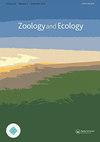On collection of predatory thrips (Insecta: Thysanoptera) in wheat fields
Q4 Environmental Science
引用次数: 2
Abstract
Some thrips species are known as predators of eggs, exist as the inactive stages of mites, and can be tiny, especially phytophagous thrips. This study aimed at evaluating the population fluctuation and species diversity of predatory thrips in wheat fields of Eyvan county (Ilam province, Iran) in the year 2016. Thrips specimens were collected and identified by weekly sampling during wheat growth stages (from early April to late June). Wheat bushes were shaken on a white dish. Finally, microscopic slides were prepared and all samples were enumerated. The population fluctuation of predatory thrips was calculated. In this study, six species of predatory thrips belonging to three genera were identified. Amongst them, Aeolothrips intermedius Bagnall (family Aeolothripidae) was the dominant species in both irrigated and rainfed wheat fields accounting for 72.43% and 50.85% of all species, respectively. Biodiversity indices were calculated using the number of species and their relative abundance. Shannon diversity, Simpson’s, Margalef’’s and species richness indices were 1.76, 0.86, 1.25 and 1, respectively. The highest biodiversity was in rainfed fields and during the wheat flowering stage, and the highest Shannon-Wiener evenness index was also in rainfed fields and at the ripening stage. The richness of thrips in rainfed wheat fields during the stem elongation stage was higher than in other wheat stages. Correlation of the density of predatory thrips with temperature and humidity showed a significantly positive correlation with temperature.麦田捕食性蓟马(昆虫纲:蓟马目)的采集
一些蓟马物种被称为卵的捕食者,作为螨虫的不活跃阶段存在,并且可以很小,特别是植食性蓟马。本研究旨在评价2016年伊朗伊拉姆省艾文县麦田食肉蓟马种群消长和物种多样性。在小麦生育期(4月上旬至6月下旬),采用每周抽样的方法采集和鉴定蓟马标本。麦丛在一个白色的盘子上摇晃着。最后制备显微载玻片,对所有样品进行枚举。计算了捕食性蓟马种群消长。本研究共鉴定了3属6种食肉蓟马。其中,灌溉麦田和旱作麦田的优势种均为中级风蓟马(aeolothrip intermedius Bagnall),分别占总种数的72.43%和50.85%。利用物种数量及其相对丰度计算生物多样性指数。Shannon多样性指数、Simpson’s指数、Margalef’s指数和物种丰富度指数分别为1.76、0.86、1.25和1。多样性在旱地和小麦开花期最高,Shannon-Wiener均匀度指数在旱地和成熟期最高。旱作麦田茎秆伸长期蓟马丰富度高于其他小麦生育期。捕食性蓟马密度与温度、湿度呈显著正相关。
本文章由计算机程序翻译,如有差异,请以英文原文为准。
求助全文
约1分钟内获得全文
求助全文
来源期刊

Zoology and Ecology
Agricultural and Biological Sciences-Animal Science and Zoology
CiteScore
1.00
自引率
0.00%
发文量
1
 求助内容:
求助内容: 应助结果提醒方式:
应助结果提醒方式:


